(August 15, 2024) – When you think Wisconsin, there’s a good chance you think of peaceful scenes of cows grazing on the horizon. Now, our cows, along with our farmers and ranchers, are helping to protect our state’s grassland birds.
Famous for its dairy cows, Wisconsin is also a proud cattle ranching state. But over the years, as many native prairies were converted into working lands, we’ve lost many of the grasses, sedges and wildflowers that grassland birds need.
Some agricultural practices, including the planting of row crops, hay fields that are cut in spring or early summer, and intense grazing offer little to no habitat to grassland birds. Others, like lighter rotational grazing – where cattle graze in one area and quickly move to the next – can boost agricultural productivity while benefiting grassland bird habitat.
We recently announced the launch of Audubon Conservation Ranching (ACR) in Wisconsin, a partnership with producers to enhance grassland bird habitat on their privately owned lands. Audubon Conservation Ranching participants carry out regenerative grazing practices that use Wisconsin’s cattle as “habitat helpers,” to improve soil health and plant diversity. The practices mimic natural and historical grazing that bison once accomplished when moving through Wisconsin’s landscapes.
Farms and ranches that meet the habitat, environmental sustainability, and animal welfare requirements of the program receive a certification on beef and bison products grazed on Audubon Certified bird-friendly lands. Consumers support conservation when they select products from these lands.
Grassland species across North America have declined more than 50 percent since 1966, and these losses are being felt across Wisconsin as land use is changing, and larger, more intensive agricultural operations are becoming more common. Let’s explore a few of Wisconsin’s grassland species that this important program is working to protect:
Greater Prairie-Chicken
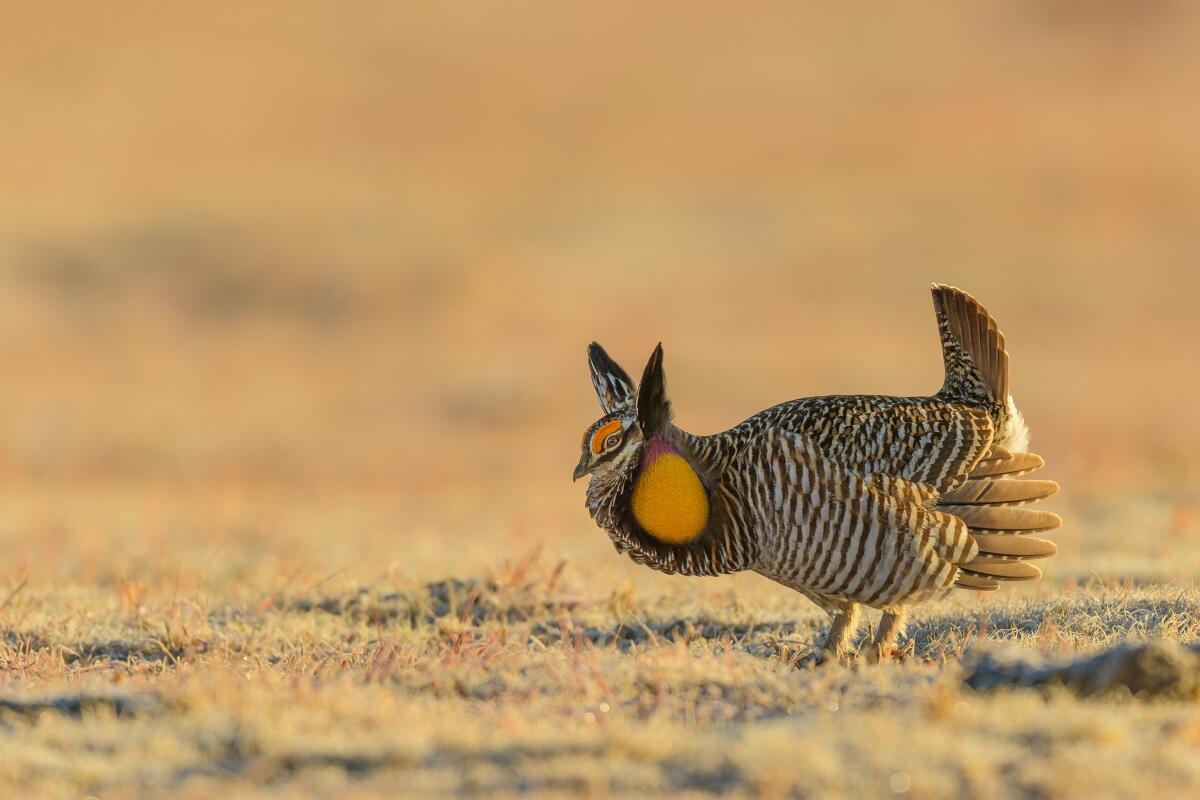
The eerie, hollowing sound of the Greater Prairie-Chicken's ‘booming’ courtship display almost disappeared from Wisconsin in the mid 20th century. Conservation efforts by Wisconsin Department of Natural Resources and other conservation groups have helped to ensure its survival in a small area of central Wisconsin, but threats remain. The Greater Prairie-Chicken is now listed as a “Species of Greatest Conservation Need,” in Wisconsin, and only exists in small populations in the center of the state.
Grassland needs: The Greater Prairie-Chicken requires a large track of open, relatively treeless landscape, mostly in grass cover. It builds its nests in shallow depressions on the ground among thick and tall grass. The female lines the nest with grass, leaves and feathers. Thicker areas of grass are used for nesting while thinner and shorter areas of grass are used for raising young and feeding.
Grasshopper Sparrow
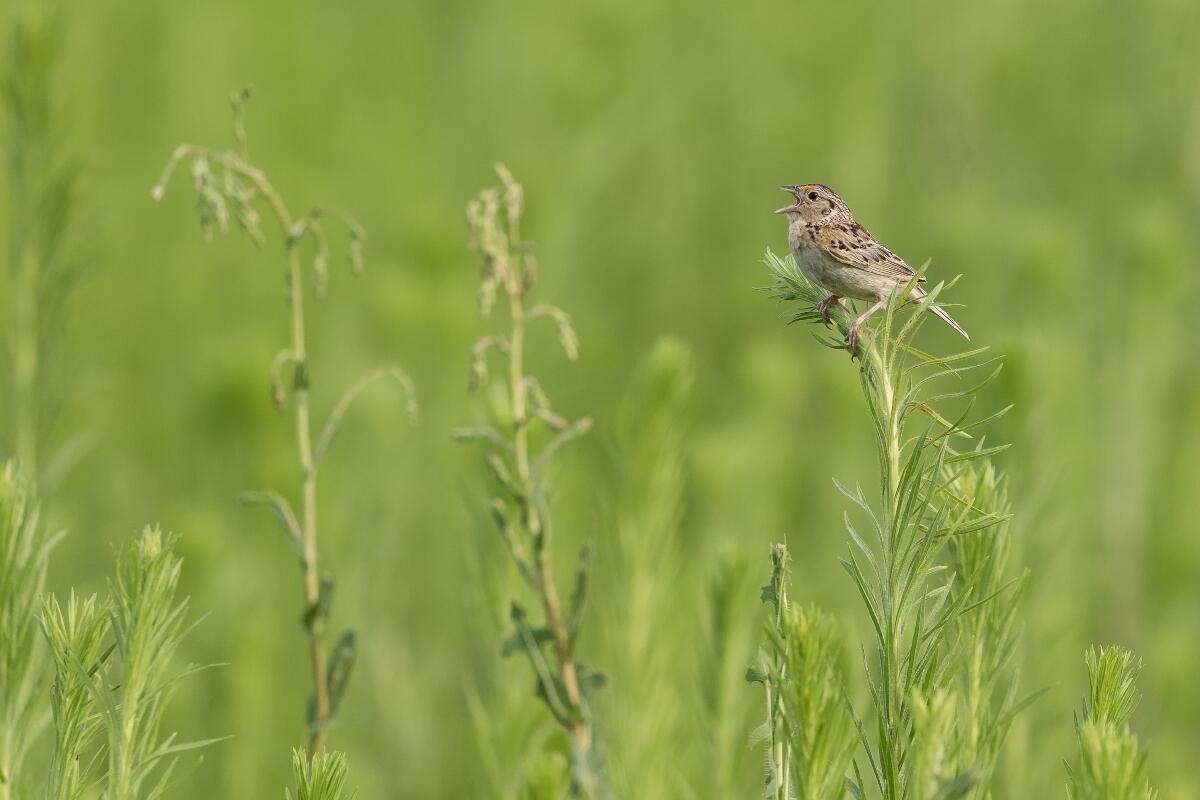
So-called because its song sounds like a buzzing grasshopper, you may have trouble spotting the Grasshopper Sparrow in the field, given its small size. While the Grasshopper Sparrow still has a strong population throughout the U.S., its range is decreasing, in large part due to habitat loss in these grasslands where it nests.
Grassland needs: Grasshopper Sparrows need a thinner grassland with little or no residual vegetation. The species especially prefers areas with warm-season grasses and sandy soil. When the Grasshopper Sparrow isn’t hiding in the grass, this bird perches on weed stalks, quickly diving headfirst back into cover if it’s disturbed. Female Grasshopper Sparrows build their nests at the base of weeds, shrubs, or grass clumps, flat on the ground, lined with grass, roots, and animal hair.
Henslow’s Sparrow
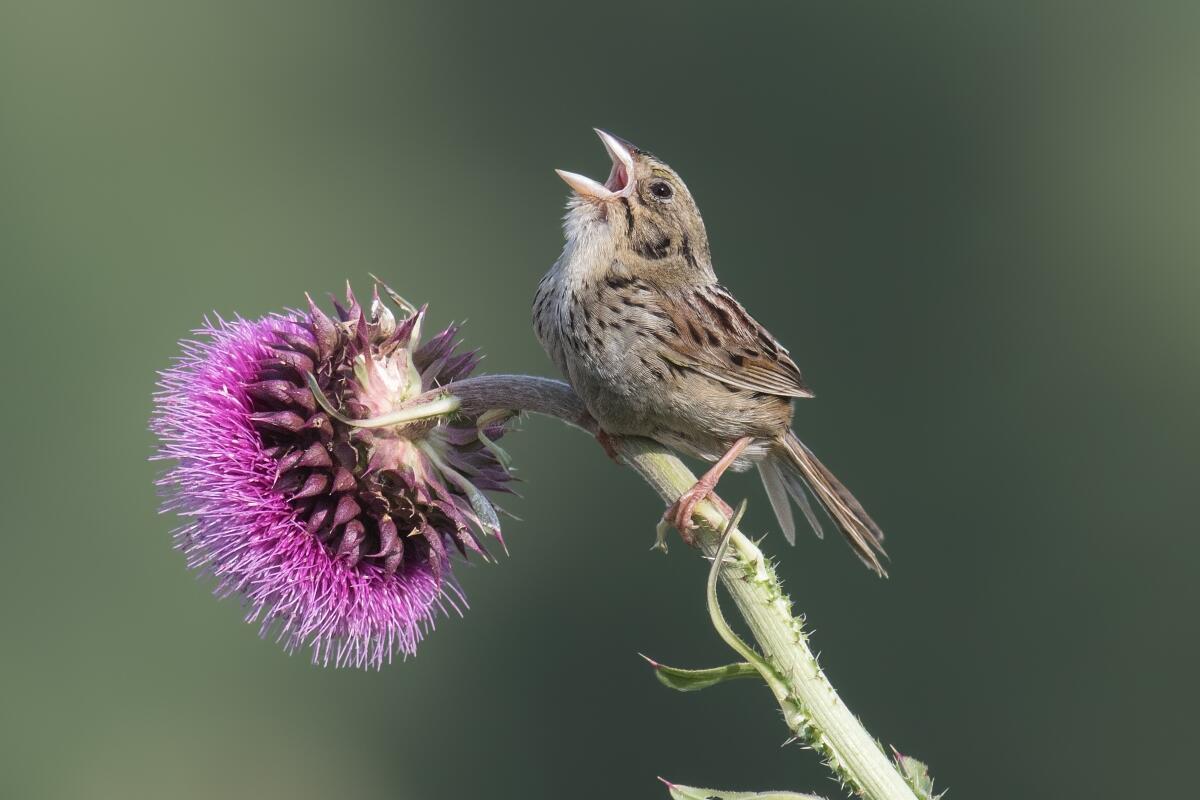
The Henslow’s Sparrow, usually hiding in dense grass, is notoriously hard to find unless it decides to climb to the top of a grass stalk to let out its (sadly, unimpressive) hiccup-like song. This species lost an average of eight percent of its entire population each year between 1966 and 1989—the steepest decline of any North American songbird. Both the breeding and wintering grounds of Henslow’s Sparrow are threatened, which means this bird is especially elusive and in peril. It's endangered in seven states and listed as state-threatened in Wisconsin.
Grassland needs: Henslow’s Sparrows nest on or very close to the ground, often arching grass over the top of the nest to conceal them. They're picky too: grasslands need two or three years of vegetation accumulation to become suitable sites for nesting. Males will take bits of grass in their bill and lead females to these low-lying nesting sites as courtship. This species needs grasslands for more than just nesting. Henslow’s Sparrows forage alone, and only on the ground, searching for insects and seeds.
Bobolink
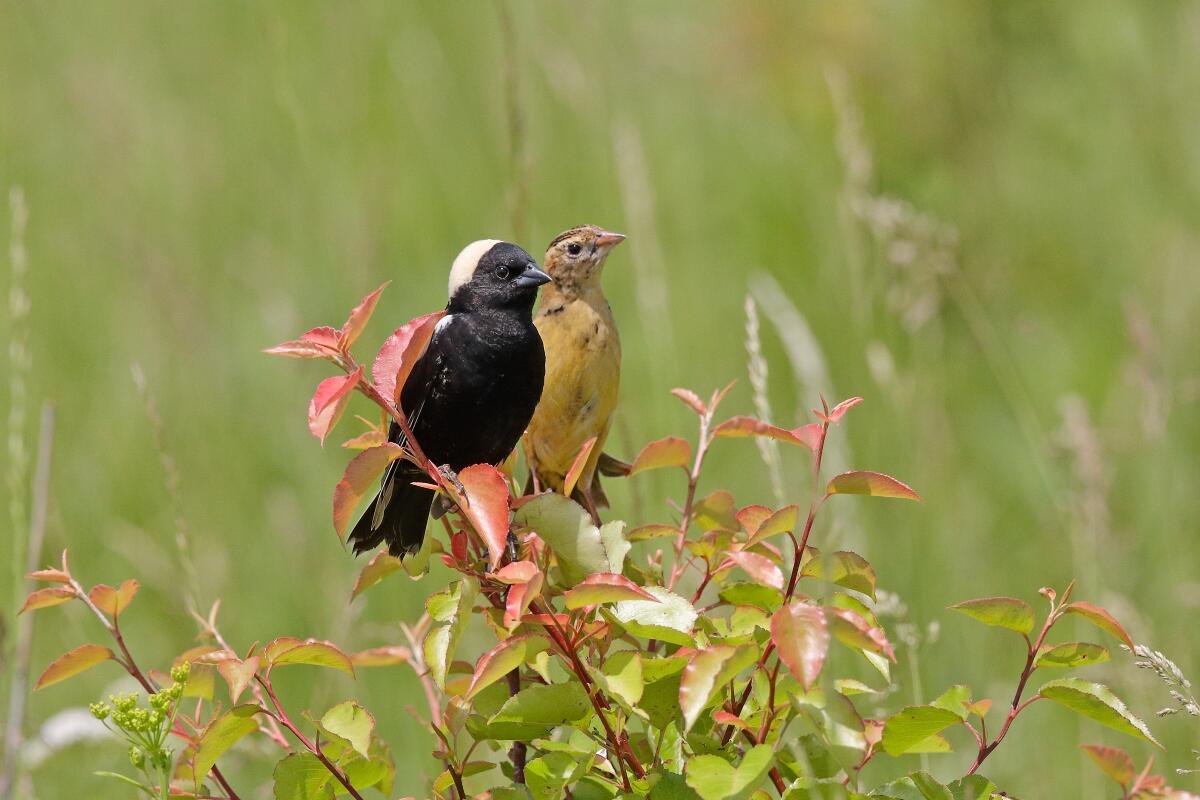
You can instantly recognize a Bobolink by its combination of bright black and white with a soft yellow nape on the back of the male’s head and its long warbling song that it usually sings while in flight, which many say sounds like R2-D2 from Star Wars. Bobolink populations have been declining significantly in recent decades, likely due to a loss of suitable habitats. The Bobolink lost 80 percent of its entire population from 1966 to 1989.
Grassland needs: The Bobolink makes nests on the ground in hayfields, meadows, and natural prairies with dense grass. Giving grassland habitats the opportunity to grow provides more space for Bobolink nesting, and helps the species’ populations stabilize and recover. Due to its love of hayfields, delayed haying is an excellent way to help this species thrive.
Eastern Meadowlark

Meadowlarks are an icon of Wisconsin’s grasslands—which is why they’re the bird featured on the Audubon Conservation Ranching Seal. You can recognize the Eastern Meadowlark, the more common of the two meadowlark species in Wisconsin, by the black V on their yellow chest and their clear, whistling song that appropriately states "spring of the year!". They can be admired from perches such as fenceposts or the tops of shrubs.
Grassland needs: Meadowlarks prefer grass length and density in the middle of the spectrum. Like Bobolink, meadowlarks are often drawn to hayfields so delayed haying is a significant help to them. These birds place their dome-shaped nests on the ground in areas with dense grass and low cover. They usually carve out little trails or “runways” leading to their nests, which have an entrance on the side. Like other grassland birds, the Eastern Meadowlark forages by walking on the ground, picking at insects and seeds.
Upland Sandpiper
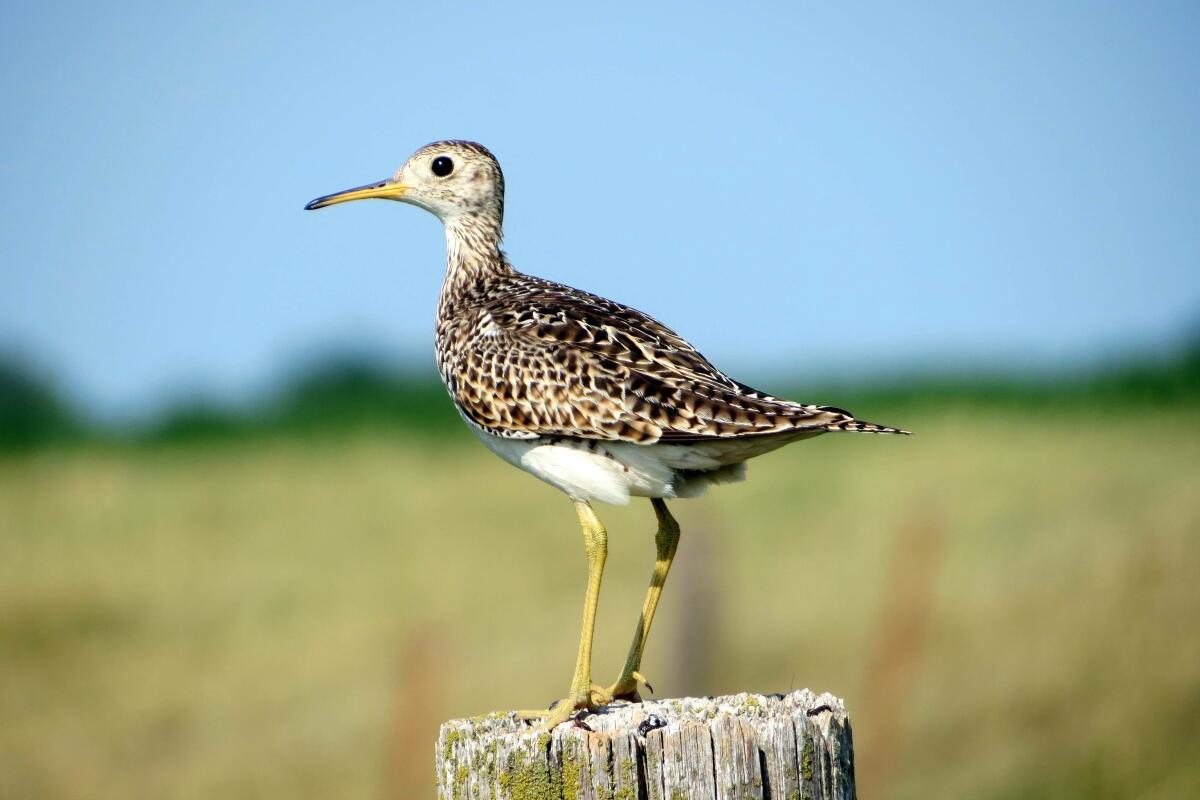
Among the characteristic sounds of spring in remaining large grasslands is the wolf whistle of Upland Sandpipers—a breathy sound that may come from above as they sing while flying. Males make displays above their breeding territory with these song flights, often very high above the grasslands and with shallow, fluttering wingbeats. Unlike any other shorebird, they'll perch high on prominent perches like telephone posts and wires.
Grassland needs: Upland Sandpipers rely on a mix of available open habitat, often including long thick grass for nesting next to shorter grass as a result of grazing or even crop fields for foraging and raising young. They may nest in colonies, with all of the pairs and chicks in a group going through their nesting stages at the same time. These nests tend to be very well-hidden among dense grass, with an arch of camouflaging grass placed above it. While these birds were once much more common, periods of hunting in the late 1800s, combined with habitat loss, has resulted in their population becoming more local and isolated.
Tracking Conservation Success
Audubon conservation staff and volunteers actively track birds on every farm in the program to ensure that efforts are helping grassland species. Nationwide, more than 100 ranches and nearly 3 million acres that have earned status as Audubon Certified bird-friendly land. At the first 35 Audubon Certified bird friendly ranches that were monitored across the nation, grassland bird abundance increased by 36 percent. There are other benefits, too: patchy habitat structure that birds need is also great for pollinating insects like monarch butterflies and bees. These healthier grasslands retain more water, reduce runoff, and improve water and soil quality. The healthier the grasslands, the more resilient they’ll be against future threats and the impacts of climate change.
This program is one important way that we can work together to preserve habitats and vulnerable birds. If you’re looking for ways to step up your conservation consciousness, check for the Audubon Certified bird-friendly seal on beef or bison products, and learn more about the success of Audubon Conservation Ranching in the Great Lakes and other states as the initiative continues to get underway in Wisconsin!










